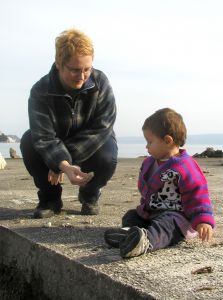From Duke University
 Adverse experiences early in life can lead to minor childhood behavior problems, which can grow into serious acts of teen violence, according to new research. This “cascading effect” of repeated negative incidents and behaviors is the focus of an article in the November/December 2008 edition of Child Development.
Adverse experiences early in life can lead to minor childhood behavior problems, which can grow into serious acts of teen violence, according to new research. This “cascading effect” of repeated negative incidents and behaviors is the focus of an article in the November/December 2008 edition of Child Development.
Using a novel approach that went beyond simply identifying risk factors, a research team led by a Duke University psychologist measured how violent behavior develops across the life span, from early childhood through adolescence.
The researchers tracked children from preschool through adulthood and documented that children who have social and academic problems in elementary school are more likely to have parents who withdraw from them over time. That opens the door for them to make friends with adolescents exhibiting deviant behaviors and, ultimately, leads them to engage in serious and sometimes costly acts of violence.
About the Study
The researchers followed 754 children from 27 schools in four different areas in the United States for 12 years. The data included school records covering kindergarten through eleventh grade and annual reports collected from the children, their parents, peers, and observers.
The article, “Testing an Idealized Dynamic Cascade Model of the Development of Serious Violence in Adolescence,” appears in Vol. 79, Issue 6, of Child Development, a publication of the Society for Research in Child Development, Inc.
The developmental path toward violent outcomes was largely the same for boys and girls, said Kenneth A. Dodge, the lead author of the study and director of the Center for Child and Family Policy at Duke University.
Child Temperament a Risk Factor
Dodge and his colleagues in the Conduct Problems Prevention Research Group also found that the cascade could be traced back to children born with biological risks or born into economically disadvantaged environments, both of which make consistent parenting a challenge.
About the Research Group
The Conduct Problems Prevention Research Group is made up of scientists from Duke University, Pennsylvania State University, Tufts University, The University of Alabama, University of South Carolina, and University of Washington.
The Research Group determined biological risk by assessing the temperaments of the children in infancy, based on mothers’ reports; those at risk were irritable, easily startled, and difficult to calm. These children are more likely to exhibit minor social and cognitive problems upon entering school. From there, the behavior problems begin to “cascade,” Dodge said.
Positive Interactions Make a Difference
“The findings indicate that these trajectories are not inevitable, but can be deflected at each subsequent era in development, through interactions with peers, school, and parents along the way,” said Dodge, who is the William McDougall Professor of Public Policy and a professor of psychology and neuroscience at Duke. “Successful early intervention could redirect paths of antisocial development to prevent serious violent behavior in adolescence.”
Fortunately, successful interventions, such as parent training and social cognitive skills training for children, are available, he said.
 People talk about the “problem child,” but I’m not really sure what a problem child is.
People talk about the “problem child,” but I’m not really sure what a problem child is. A January 6 article in the United Kingdom’s Nursery World magazine, “A Unique Child: Attachment – Practice in Pictures – A Sense of Security,” illustrates the difference between a securely and insecurely attached child.
A January 6 article in the United Kingdom’s Nursery World magazine, “A Unique Child: Attachment – Practice in Pictures – A Sense of Security,” illustrates the difference between a securely and insecurely attached child. According to an article on InTheNews.co.uk, “One in Four Aussie Kids Have Parent with Mental Illness,” mentally ill parents are more likely to form insecure attachments with their children.
According to an article on InTheNews.co.uk, “One in Four Aussie Kids Have Parent with Mental Illness,” mentally ill parents are more likely to form insecure attachments with their children. Our children model our behavior. When surrounded by people who love them and respond to them sensitively and empathetically, they learn to respond this way to others. In my view, the API principle of Responding with Sensitivity best illustrates the concept of Attachment Parenting (AP). I may or may not adhere to all the principles of AP, but if emotional responsiveness does not permeate my parenting, then I question whether I can cultivate a strong bond with my children.
Our children model our behavior. When surrounded by people who love them and respond to them sensitively and empathetically, they learn to respond this way to others. In my view, the API principle of Responding with Sensitivity best illustrates the concept of Attachment Parenting (AP). I may or may not adhere to all the principles of AP, but if emotional responsiveness does not permeate my parenting, then I question whether I can cultivate a strong bond with my children.
 When a parent utters the word tantrum to another parent, the reaction is either a supportive smile or a grimace of dread; I have yet to see or hear another parent respond with glee. And really, who blames her? Until recently, tantrums were considered manipulation by the child to control the parent.
When a parent utters the word tantrum to another parent, the reaction is either a supportive smile or a grimace of dread; I have yet to see or hear another parent respond with glee. And really, who blames her? Until recently, tantrums were considered manipulation by the child to control the parent. According to an article on the United Arab Emirates’ TheNational.ae, “More than Sadness,” the rate of children with depression in the UAE is on the rise.
According to an article on the United Arab Emirates’ TheNational.ae, “More than Sadness,” the rate of children with depression in the UAE is on the rise. An article on the United Kingdom’s TimesOnline.com, “Tackle Child Obesity: Teach Mums to Eat,” explains how the solution to rising childhood obesity is in teaching parents that their eating behavior is how children themselves learn to eat.
An article on the United Kingdom’s TimesOnline.com, “Tackle Child Obesity: Teach Mums to Eat,” explains how the solution to rising childhood obesity is in teaching parents that their eating behavior is how children themselves learn to eat.